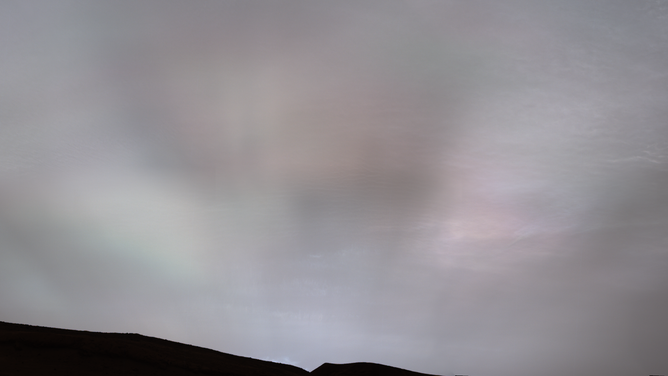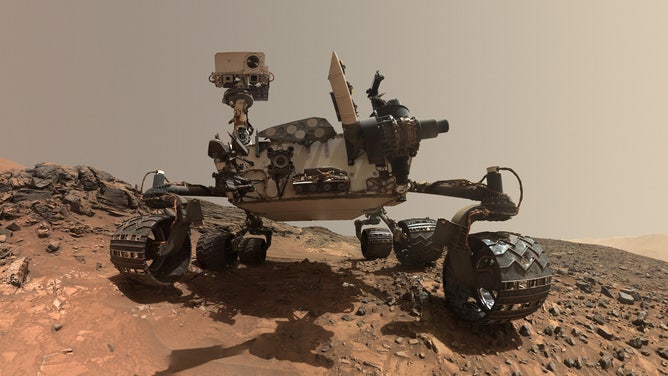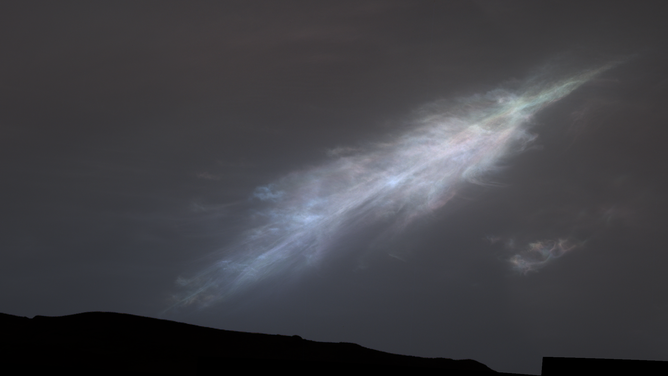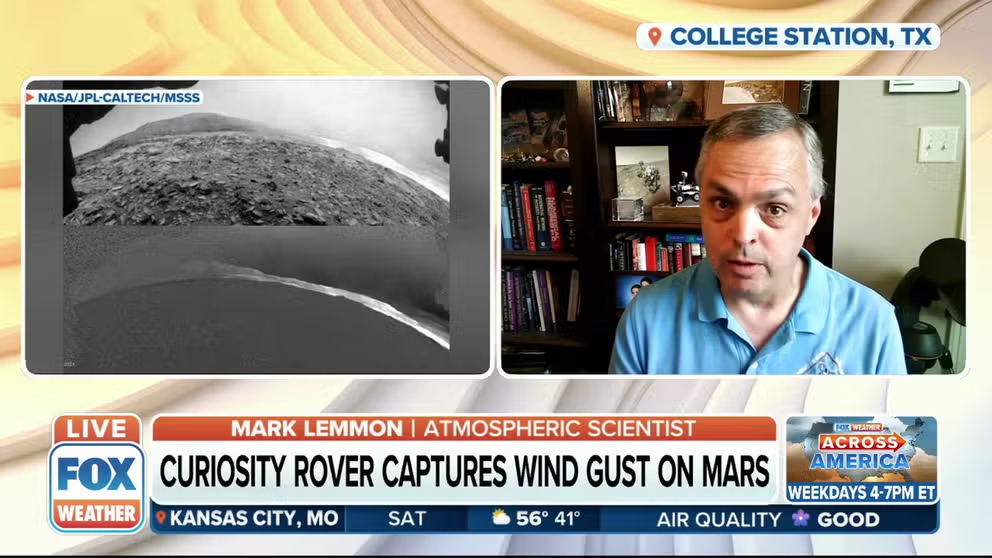See Martian sun rays: 'First time sun rays have been so clearly viewed on Mars,' NASA said
NOAA's Curiosity rover took color photos of crepuscular rays as the sun set over the red planet. These are the first photos of the phenomenon released.

(NASA/JPL-Caltech/MSSS/SSI / NASA)
It took 10 years of photographing Mars but, NASA's Curiosity rover finally caught the "first sun rays on Mars," according to NASA.
"It was the first time sun rays have been so clearly viewed on Mars," NASA said in a statement.
The rays are crepuscular rays which are alternating bands of light and dark, which are rays and shadows, seen at the earth's surface when the sun shines through clouds, according to NOAA. Curiosity proved that Mars has the rays too.

File: Curiosity is the largest rover ever sent to Mars.
(NASA / NASA)
Curiosity took photos as the sun dropped below the horizon and a bank of clouds on February 2. The photos are part of the rover's twilight cloud survey.
What is a crepuscular ray?
"Crepuscular rays are simply long shadows cast by clouds, mountains, or other objects that block the light of the sun," Michael Kavulich, an associate scientist with the National Center for Atmospheric Research, told FOX Weather previously.
In the Earth's atmosphere, he said the shadows at sunset could stretch for 1,000 miles long.
LAST GLIMPSE OF SEATTLE SUMMER SUNLIGHT PUTS ON HEAVENLY SHOW: CREPUSCULAR RAYS

Crepuscular rays shine as the sun sets in Seattle on July 24, 2022.
(Sigma Sreedharan Photography / FOX Weather)
"We don't often notice (except for *very* hazy days), but even on clear days a little bit of sunlight is getting scattered by pollen, dust, smoke, and pollution," Kavulich continued. "In this way we can see the ‘clear’ air as slightly brighter than the same air that wasn't illuminated by the sun."
On Mars clouds, mountains and the iconic dust devils and storms create the shadows.
NASA'S MARS ROVER REVEALS DIVERSITY OF WILD WEATHER ON THE RED PLANET
Curiosity Rover captures dusty wind gust on Mars
Images captured by NASA’s Curiosity Rover reveal a dusty wind gust on Mars. The technology and growing potential can show us about the weather on a different planet. Mark Lemmon, an atmospheric scientist at the Space Scientist Institute and Curiosity Rover team member, joins FOX Weather.
LISTEN TO A MARTIAN DUST DEVIL: THE FIRST RECORDING EVER COULD BE THE KEY TO FUTURE MISSIONS
The shadows run in parallel lines to each other, but since Earth and Mars are spheres, the shadows instead appear to the eye to converge on where the sun is setting. Think of how train tracks point toward the horizon. The tracks run parallel to each other all the time but appear to converge to a point on the horizon.
But if you were to flatten the sky out instead of a sphere, you would just see straight parallel lines of shadow streaking across the sky, Kavulich said.
Why is a Martian sunset blue?

Curiosity took a sequence of photos of the Martian sunset over 6 minutes, 51 seconds on April 15, 2015. This was the first color sunset captured by Curiosity.
(NASA/JPL-Caltech/MSSS/Texas A&M Univ. / NASA)
THE SCIENCE BEHIND COLORFUL SUNRISES, SUNSETS
While Mars is nicknamed the "red planet," the sunsets look blue. During the day, the red dust looks red. But optics change as the sun sets and has to go through more atmosphere to reach the surface.
"The colors come from the fact that the very fine dust is the right size so that blue light penetrates the atmosphere slightly more efficiently," said Mark Lemmon of Texas A&M University, College Station, a science team member of the Curiosity rover mission in a statement.
"When the blue light scatters off the dust, it stays closer to the direction of the Sun than light of other colors does," he continued. The rest of the sky is yellow to orange, as yellow and red light scatter all over the sky instead of being absorbed or staying close to the Sun."
Lemmon said that the glow from a Martian twilight lasts for up to 2 hours, much longer than Earth twilight. Abundant dust high in the scatterers the sunlight, making the sky glow even if the sun is below the horizon.
What secrets do noctilucent clouds tell?
NASA's aim was to photograph noctilucent clouds or night shining clouds and build on its 2021 research. The clouds we are familiar with are made up of ice and water. Martian clouds are too and sit no more than 37 miles above the red planet. Noctilucent clouds are at a much higher altitude and scientists feel they are made up of dry ice or carbon dioxide ice.
NOCTILUCENT CLOUDS: HOW METEORSMOKE CAN TURN INTO A DAZZLING DISPLAY OF GLOWING CLOUDS AT DUSK

Curiosity's Mastcam took this image which is actually a compilation of 28 individual images of a noctilucent cloud on March, 6 2023.
(NASA/JPL-Caltech/MSSS / NASA)
NASA scientists study where and when the clouds form to learn more about the Martian atmosphere's composition, high level winds and temperature. The color Mastcam records how clouds grow over time. Take a look at the colorful iridescence of the cloud in the picture above.
"Where we see iridescence, it means a cloud’s particle sizes are identical to their neighbors in each part of the cloud," said Mark Lemmon, an atmospheric scientist with the Space Science Institute in Boulder, Colorado in a NASA statement. "By looking at color transitions, we’re seeing particle size changing across the cloud. That tells us about the way the cloud is evolving and how its particles are changing size over time."
Curiosity's twilight cloud study is scheduled to wrap up in mid-March.
